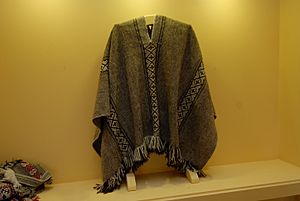Mapuche textiles facts for kids
The Mapuche people are famous for their beautiful textiles. This art form has a very long history, going back to before Europeans arrived. Mapuche textiles are still made today. Before the 1900s, Mapuche textiles, especially ponchos, were very important for trading.
Contents
A Look Back: History of Mapuche Textiles
In ancient Andean societies, textiles were super important. People used them for clothes, tools, and even parts of their homes. Textiles also showed how important someone was. In the 1500s and 1600s, Mapuche people in the Araucanía region wanted Spanish clothes and fabrics. They even asked for them as war trophies in peace deals with the Spanish. When someone died, the Mapuche would dress them in their best clothes and finest textiles for their funeral.
Ancient Discoveries: Where Did Textiles Begin?
The oldest clues about textiles in southern South America come from archaeological digs. Places like the Pitrén Cemetery near Temuco and the Alboyanco site in the Bío Bío Region of Chile show us this. Also, the Rebolledo Arriba Cemetery in Neuquén Province, Argentina, has similar finds. Researchers found fabrics made with complex designs and weaving styles. These ancient textiles are from around 1300 to 1350 AD.
From Camel Hair to Sheep Wool
The first written records about Mapuche textile art are from the 1500s. These are stories from European explorers and settlers. They wrote that when Europeans first came to the Araucanía region, local people wore textiles made from camel hair. This came from animals like alpacas and llamas.
Later, the Spanish brought sheep to the area. The Mapuche then started raising sheep and using their wool for weaving. Slowly, sheep wool replaced camel hair. By the late 1500s, the Mapuche had even bred their own sheep. These sheep had stronger bodies and thicker, longer wool. They were much better suited for the local weather.
Who Made the Textiles?
Mapuche women were the ones who spun the yarn and wove the fabrics. They learned weaving techniques and special patterns from their families. Mothers, grandmothers, and aunts taught younger girls what they had learned from their own elders.
Women who were excellent weavers were highly respected. They helped their families a lot, both economically and culturally. To show how important weaving was, a man would offer a larger dowry for a bride who was a skilled weaver.
Trading Textiles: An Important Business
The Mapuche also used their textiles for trade. They made more textiles than they needed for themselves. Many stories from the 1500s describe them trading textiles with other native groups. They also traded with the new European settlements. This trading allowed the Mapuche to get things they didn't make, like horses.
The amount of fabric made by Mapuche women and sold in Araucanía and northern Patagonia was huge. It was a very important way for families to earn money. It was clear that textiles were made for more than just home use. In the 1800s, Mapuche ponchos were even better than Chilean textiles made by non-native people. They were also very good quality compared to European wool textiles of that time. Reports from that period say a poncho could be traded for several horses. It could also be traded for up to seventy kilos of yerba mate, a popular drink.
Mapuche Textiles Today
Today, Mapuche textiles are still used in homes. They are also given as gifts, sold, or traded. Most Mapuche women and their families now wear clothes with modern designs. These clothes are made from factory-produced materials. However, they still weave ponchos, blankets, bands, and belts for everyday use. Many fabrics are woven specifically for trade. This often provides an important income for families.
Many Mapuche women continue to weave fabrics just like their ancestors did. They pass on their knowledge in the same way: within the family, from mother to daughter, and from grandmothers to granddaughters. This learning style is mostly about watching and copying. Only rarely do students get clear instructions or help. The knowledge is passed down as the fabric is woven. Weaving and learning go hand in hand.


